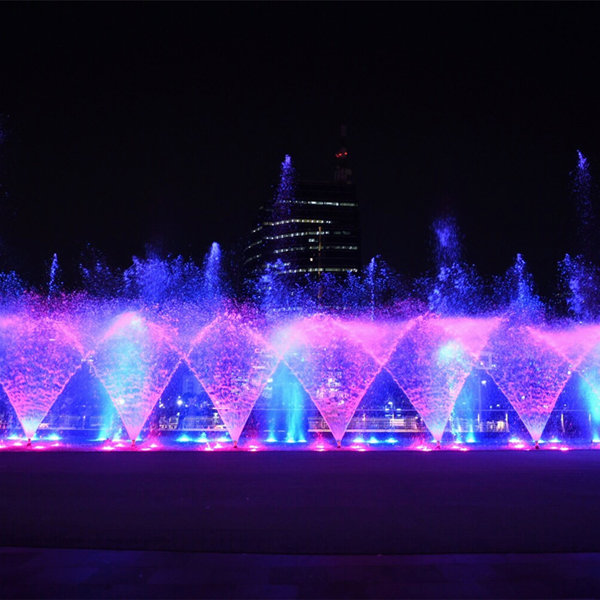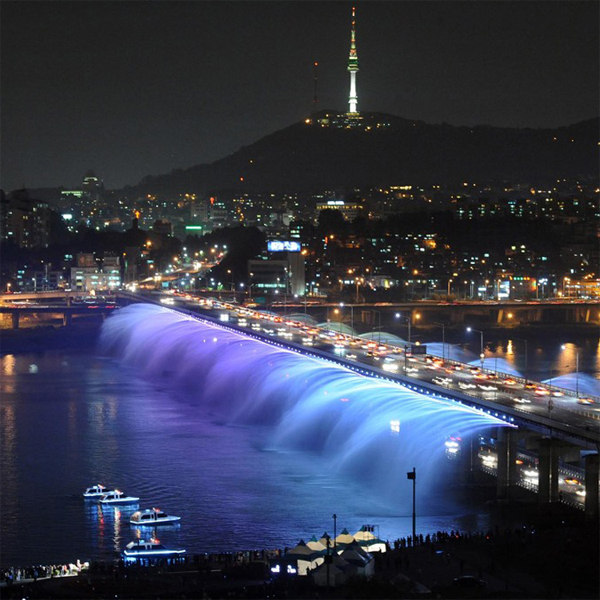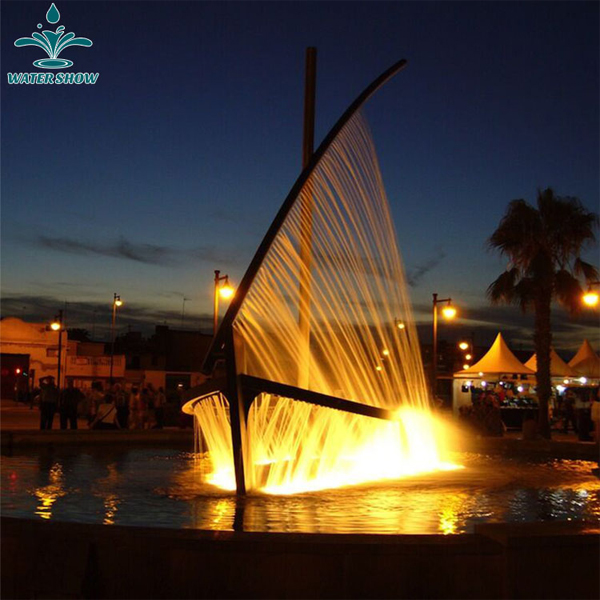16 Oct 2020
Familiar with the design drawings and master the status of the construction site. Before construction, you should first have an overall analysis and understanding of the musical fountain design drawings, experience its design intentions, and master the design techniques. On this basis, conduct construction site surveys and have an overall grasp of the site construction conditions. Which conditions can be fully utilized, which must be cleared, etc.
Doing a good job in engineering affairs is based on the specific requirements of the project, preparing construction budgets, implementing the project contract, preparing construction plans, drawing construction charts, formulating construction specifications, safety measures, technical responsibility systems, and management regulations.
Measure and set the line of the proposed pool, and then excavate the earth. When the earth is excavated to the level required by the design, check whether the soil quality is consistent with the design data. If there is any change, deal with different situations, such as foundation When the soil is soft or backfilled, methods such as replacing the soil and ramming it or increasing the thickness of the bottom plate can be adopted to achieve the foundation bearing capacity required by the design, so as to avoid uneven settlement due to insufficient foundation bearing capacity, resulting in the bottom plate cracking, and finally pour the concrete Cushion.
After pouring the concrete cushion layer for 1-2 days (depending on the temperature during construction), measure and set the line on the cushion layer according to the construction drawings, and release the bottom line and the edge of the pool wall.
When tying rebars, check the diameter, spacing, location, lap length, spacing of upper and lower rebars, protective layer and the location and quantity of embedded parts in detail, and all shall meet the design requirements. The upper and lower rebars are fixed with iron braces (iron horse stools) so that they will not be displaced during the pouring process. During the concrete pouring process, rebar workers are arranged to follow the steps to adjust the stepped negative rebars to avoid negative rebars. The bottom rib is used, causing cracking.
For the support pool, pool wall, and top template, the inner mold should be erected first, and the steel bars should be tied up, and then the outer mold should be erected. In order to make the template have sufficient strength, rigidity and stability, the inner and outer molds should be fastened with tie bolts and steel pipes. The inner ring of the inner mold is tightened with blue bolts and screw braces.

The bottom plate and pool wall should be poured continuously at one time without leaving construction joints. The construction interval shall not exceed the initial setting time of concrete. If the concrete is initially set or segregated during transportation, it must be mixed twice on the on-site mixing plate before it can be poured into the mold. If the thickness of the bottom plate is less than 20cm, a flat-plate vibrator can be used. When the thickness of the plate is thicker, a plug-in vibrator can be used.
After the concrete is poured, vibration is forbidden when its strength does not reach 162N/mm2. Scaffolding, formwork and transportation tools are not allowed on the bottom plate, and the concrete maintenance work should be done.
The wall of the landscape pool adopts the method of supporting molds, and the inner and outer molds are erected once after the steel bars are bound. During concrete construction, pour in layers. After removing the mold from the pool wall, cut off the exposed water-stop bolt heads and apply anti-rust paint. The construction of the pool should prevent the occurrence of deformation cracks. The following measures can be taken during construction.
Ordinary Portland cement is used in the construction of the pool. The maximum particle size of the stones used is not more than 40mm, and the water absorption rate is not more than 1.5%. The cement dosage per cubic meter of the pool wall concrete should not be less than 320kg, and the sand content should be 35%-40%; the lime-sand ratio should be 1:2~1:2.5; the water-cement ratio should be less than 0.6. The impermeable waterproof concrete with impermeability grade S6.
When the height of the pool wall is large and 600mm high, the fixed formwork should adopt a water stop rod and take water stop measures. The common water stop measures are as follows. Welded water stop ring on screw inspection: The water stop ring should be fully welded, and the number of rings should be determined by design according to the thickness of the pool wall. Bolts and plugs: When supporting the mold, add plugs on both sides of the bolts. After removing the mold, cut off the corners of the bolts along the bottom of the flat pit and seal them tightly with expanded cement mortar.
If construction joints cannot be avoided, the horizontal construction joints of the pool wall should be set at a height of about 500 ram from the bottom plate, and the construction joints should be concave or buried with water-stop steel plates or expansion waterstops. The construction joints should be installed before concrete pouring of the pool wall. Gouge the concrete surface at the place, remove floating particles and debris, rinse with water, and keep it moist. Then spread a layer of cement mortar. The lime-sand ratio of the material used in the cement mortar should be the same as that of the concrete.
Concrete pouring and vibrating. When determining the concrete pouring plan, the number of constructions should be minimized. When pouring the concrete, it is advisable to start at the low place and then at the high place, first in the middle and then at both ends, to avoid cold joints. Enough vibration time should be ensured to discharge excess gas and moisture in the concrete. The bleeding on the surface of the concrete should be drained in time. The concrete on the bottom surface of the pool should be compacted and polished before initial setting, so as to obtain high strength and crack resistance. Good performance, solid concrete inside and outside.
After the concrete of the pool wall is condensed, it should be cured immediately and kept fully moist. The curing time shall not be less than 14 days and nights. When removing the mold, the temperature difference between the surface temperature of the pool wall and the surrounding air temperature shall not exceed 15℃.

Add sliding layer and compression layer. Considering that the longer pool is constrained by the foundation, a felt and oil can be used as a sliding layer between the upper surface of the cushion and the lower surface of the bottom of the pool.
Pool wall plastering construction: Before plastering, chisel the surface of the inner wall of the pool, shovel the unevenness, and rinse it with water; when plastering, brush a thin pure cement slurry on the concrete wall to increase the adhesion.
The water test work should be carried out after all the construction of the water feature pool is completed. The main purpose of the water test is to check whether the concrete structure sees water. The water test should be carried out in two times. The first water test is the structural water test. After the concrete structure is completed, the leveling layer is plastered, and water is injected after completion. According to the specific situation, the water intake height is controlled at the design water level. After irrigation to the design elevation, stop for 1 day, perform visual inspection, and mark the water surface height, and observe continuously for 7 days. If there is no penetration on the outer surface and no obvious drop of the water level, it is qualified; the second water test is the test after the completion of the waterproof layer construction. For water, the steps are the same as above, and the next process can only be carried out after the water test is qualified.
Anti-leakage treatment measures
In order to prevent water seepage in the pool, waterproof mortar should be used for plastering treatment, and the construction prevention measures are as follows.
1. The surface of the base layer should be flat, solid, rough, and clean. The rigid multi-layer cement mortar waterproof layer requires the surface to be fully moist and free of water.
2. The construction joints of the concrete structure shall be constructed according to the structure, and the “V”-shaped slope grooves shall be cut along the joints. If they are washed with water, they shall be grounded with plain ash and compacted and smoothed with cement mortar. The groove depth is generally about 10mm.
3. 425# slag Portland cement should be used, and the water-cement ratio should be reduced as much as possible to make the water-cement ratio ≤0.55. It can be mixed with calcium sulfonate water-reducing agent, and the concrete prepared with water-reducing agent is oil resistant and It has good permeability and saves cement.
4. The reinforced concrete pool has a long length due to technical requirements, and there are expansion joints on the bottom plate and the pool wall. During construction, the water-stop steel plate or water-stop rubber must be properly fixed, and attention should be paid to irrigation to prevent the water-stop steel plate and water-stop rubber from shifting.
5. Rigid multi-layer waterproof layer. It is advisable to use five-layer cross-wiping method on the front water surface and four-layer cross-wiping method on the back water surface. The surface should be calendered and the total thickness should not be less than 20mm.
6. The consistency of cement mortar should be controlled within 70mm~80mm, and the cement mortar should be used as it is mixed.
7. Both the internal and external corners of the structure should be rounded. The radius of the arc is generally 50mm for the internal angle and 10mm for the external angle.
8. The construction joints of the waterproof layer need to leave a slope ladder, and the construction should be carried out continuously in accordance with the level of operation, and the layers should be tightly overlapped.
9. The strength of the pool concrete is good or bad, and maintenance is an important part. After the bottom plate is poured, when the pool wall is constructed, care should be taken to maintain and keep it moist. After pouring the concrete of the pool wall, if the temperature is high or dry, the premature demoulding will cause the concrete to shrink and crack. Therefore, watering and curing should be continued, and the curing period of the concrete for the bottom plate, pool wall and pool wall grouting joints shall not be less than 14 days.

Keywords: musical fountain
Originally published 16 Oct 2020, updated 16 Oct 2020.